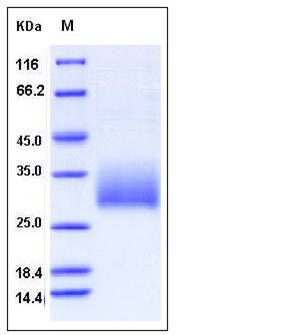| Catalog Number |
P50806-M07H |
| Organism Species |
Mouse |
| Host |
Human Cells |
| Synonyms |
ly-55A,Ly55a,NKR-P1.7,NKR-P1A,Nkrp1-a,NKRP12,Nkrp1a |
| Molecular Weight |
The secreted recombinant mouse Klrb1a comprises 180 amino acids and predicts a molecular mass of 21 kDa. As a result of glycosylation, the apparent molecular mass of mouse Klrb1a is approximately 30-35 kDa in SDS-PAGE under reducing conditions. |
| predicted N |
His |
| SDS-PAGE |
 |
| Purity |
> 95 % as determined by SDS-PAGE |
| Protein Construction |
A DNA sequence encoding the secreted form of mouse Klrb1a (P27811) (Gln 67-His 227) was fused with a polyhistidine tag at the N-terminus. |
| Bio-activity |
|
| Research Area |
|
| Formulation |
Lyophilized from sterile PBS, pH 7.4
1. Normally 5 % - 8 % trehalose and mannitol are added as protectants before lyophilization. Specific concentrations are included in the hardcopy of COA.
|
| Background |
|
| Reference |
Plougastel B, et al. (2001) Analysis of a 1-Mb BAC contig overlapping the mouse Nkrp1 cluster of genes: cloning of three new Nkrp1 members, Nkrp1d, Nkrp1e, and Nkrp1f. Immunogenetics 53: 592-598.Kogelberg H, et al. (2000) Expression in Escherichia coli, folding in vitro, and characterization of the carbohydrate recognition domain of the natural killer cell receptor NKR-P1A. Protein Expr Purif. 20(1): 10-20.Grazia Cifone M, et al. (1997) NKR-P1A stimulation of arachidonate-generating enzymes in rat NK cells is associated with granule release and cytotoxic activity. J Immunol. 159(1): 309-17.Josien R, et al. (1997) Rat spleen dendritic cells express natural killer cell receptor protein 1 (NKR-P1) and have cytotoxic activity to select targets via a Ca2+-dependent mechanism. J Exp Med. 186: 467-472.Ryan JC, et al. (1995) NKR-P1A is a target-specific receptor that activates natural killer cell cytotoxicity. J Exp Med. 181(5): 1911-5.Lanier L L, et al. (1994) Human NKR-P1A: a disulfide-linked homodimer of the C-type lectin superfamily expressed by a subset of NK and T lymphocytes. J Immunol. 153: 2417-2428.Chambers W, et al. (1989) Monoclonal antibody to a triggering structure expressed on rat natural killer cells and adherent lymphokine-activated killer cells. J Exp Med. 169: 1373-1389. |

